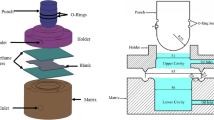Abstract
In this study, forming limit diagram (FLD) is experimentally acquired for aluminum alloy 3105 in usual velocities (Quasi-static condition). In addition, numerical simulation by commercially available finite element code ABAQUS/Explicit using ductile fracture criteria is performed. Simulation is done in quasi-static condition (\(\dot{\varepsilon} \le 0.01/s\)) and case of forming by low-impact (\(\dot{\varepsilon} \le 50/s\)).The results show that a substantial improvement in high-strain-rate formability of the aluminum sheet can be obtained.












Similar content being viewed by others
References
Keeler SP, Backhofen WA (1964) Plastic instability and fracture in sheet stretched over rigid punches. ASM Trans Q 56:25–48
Goodwin GM (1968) Application of strain analysis to sheet metal forming in the press shop. SAE paper, No 680093
Considere A (1885) Memoire sur lemploi du fer et de lacier dans les constructions. Ann Ponts Chaussees 9(6):574–775
Hollomon JH (1945) Tensile deformation. Trans Metall Soc AIME 162:268–290
Ghosh AK (1977) Tensile instability and necking in materials with strain hardening and strain-rate hardening. Acta Metall 25:1413–1424
Chung K, Wagoner RH (1986) Invariance of necking formation to material strength and strain rate for power-law materials. Metall Trans A 17A:1632–1633
Marciniak Z, Kuczynski K (1967) Limit strains in process of stretch forming sheet steel. J Mech Phys Solids 9:609–620
Wood WW (1967) Experimental mechanics at velocity extremes—very high strain-rates. Exp Mech 7:441–446
Dieter G (1976) Mechanical metallurgy, 2nd edn. McGraw-Hill, Toronto, pp 350–353
Shenoy VB, Freund LB (1999) Necking bifurcations during high strain rate extension. J Mech Phys Solids 47:2209–2233
Hu X, Daehn GS (1996) Effect of velocity on localization in uniaxial tension. Acta Mater 44:1021–1033
Altynova M, Hu X, Daehn GS (1996) Increased ductility in electromagnetic ring expansion. Metall Mater Trans 27(7):1837–1844
Gerdooei M, Dariani BM (2007) Dynamic analysis instability of sheet metal under biaxial stretching. Amirkabir J Sci Technol 18(67-B):31–39
Gerdooei M, Dariani BM (2008) Strain-rate-dependent forming limit diagrams for sheet metals. Proc IMechE, Part B, J Eng Mf 222(B12):1651–1659
Balanethiram VS, Daehn GS (1994) Hyperplasticity: increased forming limits at high work-piece velocity. Scr Mater 30:515–520
Seth M, Vohnout VJ, Daehn GS (2005) Formability of steel sheet in high velocity impact. J Mech Phys Solids 168:390–400
Imbert JM, Winkler SL, Worswick MJ, Oliveira DA, Golovashchenko S (2004) Formability and damage in electromagnetically formed AA5754 and AA6111. In: First international conference on high speed forming, Dortmund, Germany, pp 201–211
Barata Da Rocha A et al. (1985) Prediction of the forming limit diagrams of anisotropic sheets in linear and non-linear loading. Mater Sci Eng 68:151–164
Boscariol P, Gasparetto A, Zanotto V (2011) Simultaneous position and vibration control system for flexible link mechanisms. Meccanica 46:723–737
Yan X, Liu B (2011) A numerical analysis of cracks emanating from a surface elliptical hole in infinite body in tension. Meccanica 46:263–278
Momoniat E (2011) Numerical investigation of a third-order ODE from thin film flow. Meccanica 46:313–323
Basak A, Nandakumar A, Chatterjee A (2011) Decoupled three-dimensional finite element computation of thermoelastic damping using Zener’s approximation. Meccanica 46:371–381
Othman MIA, Abbas IA (2011) Effect of rotation on plane waves at the free surface of a fibre-reinforced thermoelastic half-space using the finite element method. Meccanica 46:413–421
Orakdögen E, Küçükarslan S, Sofiyev A Omurtag MH (2010) Finite element analysis of functionally graded plates for coupling effect of extension and bending. Meccanica 45:63–72
Brnic J, Turkalj G, Canadija M (2010) Shear stress analysis in engineering beams using deplanation field of special 2-D finite elements. Meccanica 45:227–235
Chazal C, Pitti RM (2010) Modelling of ageing viscoelastic materials in three dimensional finite element approach. Meccanica 45:439–441
Ellakany AM, Tablia HA (2010) A numerical model for static and free vibration analysis of elastic composite beams with end shear restraint. Meccanica 45:463–474
Jiang HY, Lee D (1992) Numerical simulation of sheet metal forming process based on large deformation sheet elements. In: Proceedings of the NUMIFORM’92, p 485
Clift SE, Hartley P, Sturgess CEN, Rowe GW (1990) Fracture prediction in plastic deformation processes. Int J Mech Sci 32:1–17
Takuda H, Mori K, Fujimoto H, Hatta N (1996) Prediction of forming limit in deep drawing of Fe/Al laminated composite sheets using ductile fracture criterion. J Mater Process Technol 60:291–296
Takuda H, Mori K, Hatta N (1999) The application of some criteria for ductile fracture to the prediction of the forming limit of sheet metals. J Mater Process Technol 95:116–121
Takuda H, Mori K, Takakura N, Yamaguchi K (2000) Finite element analysis of limit strains in biaxial stretching of sheet metals allowing for ductile fracture. Int J Mech Sci 42:785–798
Lee YS, Kwon YN, Kang SH, Kim SW, Lee JH (2008) Forming limit of AZ31 alloy sheet and strain rate on warm sheet metal forming. J Mater Process Technol 201:431–435
Wifi AS, Adbel-Hamed A, El-Abbasi N, Harmoush H (1996). In: Abe T, Tsuta T (eds) Advances in engineering plasticity and its applications. Pergamon, New York, pp 197–202
Freudenthal AM (1950) The inelastic behavior of engineering materials and structures. Wiley, New York
Cockcroft MG, Latham DJ (1968) Ductility and the workability of metals. J Inst Met 96:33–39
Bridgman PW (1952) Studies in large plastic flow and fracture. McGraw-Hill, New York
Oh SL, Chen CC, Kobayashi S (1979) Ductile fracture in axisymmetric extrusion and drawing. J Eng Ind Trans ASME 101:36–44
Sadough A, Shakeri M, Dariani BM (2000) Theoretical and experimental analysis of sheet metal formability limits. Rev Metall CIT Sci Genie Mater 663–670
Hosford WF (1979) On yield loci of anisotropic cubic metals. In: Proceedings of the seventh North American metalworking research conference. SME, Dearborn, pp 191–197
Author information
Authors and Affiliations
Corresponding author
Rights and permissions
About this article
Cite this article
Safari, M., Hosseinipour, S.J. & Azodi, H.D. An investigation into the effect of strain rate on forming limit diagram using ductile fracture criteria. Meccanica 47, 1391–1399 (2012). https://doi.org/10.1007/s11012-011-9521-2
Received:
Accepted:
Published:
Issue Date:
DOI: https://doi.org/10.1007/s11012-011-9521-2




